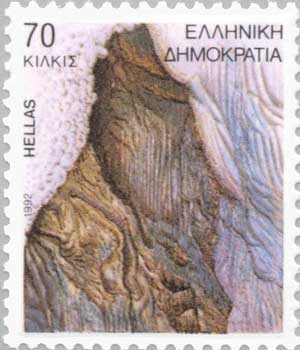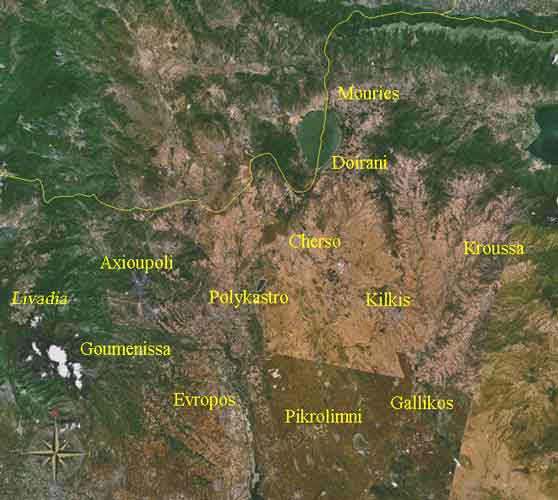.


Administrative Region : Central Macedonia
Regional unit : Kilkis
Kilkis (Greek: Κιλκίς) is an industrial city in Central Macedonia, Greece. As of 2001 there were 17,430 people living in the city proper, 24,812 people living in the municipal unit, and 56,336 in the municipality of Kilkis. It is also the capital city of the peripheral unit of Kilkis.
Name
Kilkis is located in a region that was multi-ethnic in the recent past and is known by several different names. The name of the city in early Byzantine times was Kallikon, and was also known as Kalkis or Kilkis by the Greeks. In church Codix of 1732 it is mentioned as Kilkisi (Κηλκήση)[1]. In the South Slavic languages it is known as Kukush (Кукуш, Kukuš)[2], while it was called Kilkitsi or Kılkış by the Ottomans.

Municipality
The municipality Kilkis was formed at the 2011 local government reform by the merger of the following 7 former municipalities, that became municipal units:[3]
Cherso
Doirani
Gallikos
Kilkis
Kroussa
Mouries
Pikrolimni
Division of the municipality of Kilkis, population 24812 (in 2001)
- Kilkis / Δ.δ. Κιλκίς [ 18.958 ]
- Kilkis / το Κιλκίς [ 17.430 ]
- Argyroupolis / η Αργυρούπολις [ 591 ]
- Zacharaton / το Ζαχαράτον [ 101 ]
- Kolchis / η Κολχίς [ 143 ]
- Metallikon / το Μεταλλικόν [ 371 ]
- Xirovrysi / η Ξηρόβρυση [ 172 ]
- Sevaston / το Σεβαστόν [ 150 ]
- Kilkis / το Κιλκίς [ 17.430 ]
- Vaptistis / Δ.δ. Βαπτιστού [ 504 ]
- Vaptistis / ο Βαπτιστής [ 449 ]
- Kyriakaiika / τα Κυριακαίικα [ 55 ]
- Vaptistis / ο Βαπτιστής [ 449 ]
- Kastanies / Δ.δ. Καστανιών -- οι Καστανιές [ 595 ]
- Kristoni / Δ.δ. Κρηστώνης -- η Κρηστώνη [ 1.138 ]
- Leipsydrion / Δ.δ. Λειψυδρίου [ 556 ]
- Leipsydrion / το Λειψύδριον [ 121 ]
- Akropotamia / η Ακροποταμιά [ 212 ]
- Ano Potamia / η Άνω Ποταμιά [ 105 ]
- Kato Potamia / η Κάτω Ποταμιά [ 118 ]
- Leipsydrion / το Λειψύδριον [ 121 ]
- Megali Vrysi / Δ.δ. Μεγάλης Βρύσης -- η Μεγάλη Βρύση [ 520 ]
- Melanthion / Δ.δ. Μελανθίου -- το Μελάνθιον [ 235 ]
- Mesianon / Δ.δ. Μεσιανού [ 906 ]
- Mesianon / το Μεσιανόν [ 195 ]
- Dafnochorion / το Δαφνοχώριον [ 63 ]
- Leventochorion / το Λεβεντοχώριον [ 266 ]
- Palaion Gynaikokastron / το Παλαιόν Γυναικόκαστρον [ 382 ]
- Mesianon / το Μεσιανόν [ 195 ]
- / Δ.δ. Σταυροχωρίου -- το Σταυροχώριον [ 481 ]
- Chorygion / Δ.δ. Χωρυγίου -- το Χωρύγιον [ 919 ]
History
Ancient age
Findings dating back to as early as the Bronze and Iron Age have been excavated in the vicinity of Kilkis, including ancient tombs of the 2nd millennium BC. In classical antiquity, the wider region of Kilkis was ruled by the kingdom of Macedon. At the time, Kilkis was in the center of a region called Krestonia. When Phillip II of Macedon visited Krestonia, the locals offered him olives from Krestonia valley, something that he had never eaten before[4]. At that time, many towns flourished in the region, such as Idomeni, Atalanti (Axioupoli nowadays), Gortynia (Gorgopi nowadays), Planitsa(Fyska nowadays), Terpillos, Klitae (Xylokeratia nowadays), Vragylos (Metalliko nowadays), Ioron (Palatiano nowadays), Chaetae (Tsaousitsa nowadays), Carabia (Limnotopos nowadays), Bairos (Kastro nowadays), Morrylos (Ano Apostoli nowadays), Doveros (Doirani nowadays), Evropos and Kallindria.
Roman and Byzantine era
In 148 BC, the Romans took over the area. In late antiquity the area of Kilkis saw invasions of different tribes, such as the Goths, the Huns, the Avars and the Slavs, some of whom gradually settled in the Balkan Peninsula.
In the Middle Ages, Kilkis changed hands several times between the Byzantine and Bulgarian Empires. In the 10th century, it was sacked by the Bulgarians, and some of the inhabitants moved to Calabria, in southern Italy, where they founded the village of Gallicianò. During the reign of the Palaeologus dynasty, the region saw the completion of a number of important infrastructure works.
Ottoman rule
The period of prosperity ended in 1430, when Thessalonica and the entire region of Macedonia came under Ottoman rule. After 1850, there was one Greek church, "Panagia tou Kilkis", (Madonna of Kilkis), at the foot of Saint George hill and one Greek school.
By the mid-19th century Kilkis was a primarily Bulgarian-populated town.[5][6] According to one estimate, there were about 500 Greeks, 500 Turks and 4500 Bulgarians in the town [7] at the time. A 1873 Ottoman study concluded that the population of Kilkis consisted of 1,170 households of which there were 5,235 Bulgarian inhabitants, 155 Muslims and 40 Romani people.[8] A Vasil Kanchov study of 1900 counted 7,000 Bulgarian and 750 Turkish inhabitants in the town.[9] Another survey in 1905 established the presence of 9,712 Exarchists, 40 Patriachists, 592 Uniate Christians and 16 Protestants.[10]
In 1904-1908, the Greek inhabitants of Kilkis participated in the Macedonian Struggle. The leaders of Greek efforts were Georgios Samaras, Ioannis Doiranlis and Petros Koukidis with their armed corps. Evangelia Traianou-Tzoukou and Ekaterini Stampouli were the leaders for the Greek education and hospitalization of Macedonian fighters,[11]. Great support to the Greek efforts was given by the Chatziapostolou family. The Chatziapostolou family owned a great farm in Metalliko, the field crop of which was almost completely given to fund the Greek efforts. The farm also served a shelter for the Macedonian fighters.[12]
First and Second Balkan Wars
Kilkis before the Second Balkan War.
Lithography of the Battle of Kilkis (Second Balkan War), 1913.
During the First Balkan War of 1912, the Ottoman Empire was defeated by the Balkan League and forced to concede almost all of its European territories, leaving Kilkis within the new boundaries of Bulgaria. In the Second Balkan War of 1913, the Greek army captured the city from the Bulgarians after the three-day Battle of Kilkis-Lahanas between June 19 and June 21. The battle was costly, with over 8,652 casualties on the Greek side and 7,000 on the Bulgarian side. The significance of the Battle of Kilkis-Lahanas can be appreciated by the fact that Greece named a battleship after the city, the Kilkís. Kilkis was almost completely destroyed by the Greek Army during the battle and later[13] and virtually all of its 7,000 pre-war Bulgarian inhabitants were expelled to Bulgaria. The new town was built closer to the railway tracks to Thessaloniki, around the Greek church of St. George, and was settled by Greeks transferred from Bulgaria, the Ottoman Empire and Yugoslavia, especially from Strumica; they built the Church of the Pentekaídeka Martýrōn ("15 Martyrs", named after the main Patriarchal church in Strumica). The resettled Greeks were so many that Kilkis was temporarily renamed Néa Stromnítsa (New Strumica).[14]
In the mid-twenties, after the Asia Minor Catastrophe, when Greece lost its Asia Minor territories to Turkey, waves of refugees came to Kilkis, thus giving a new boost to the region and contributing to the increase of its population. Likewise, the Turks (a generic term for the Turkish and Albanian Muslim population) of the region had to leave for the new Turkish state in the exchange of populations. By 1928, 1,679 Refugee families containing 6,433 individuals had been resettled in Kilkis.[15] Barely two decades later, World War II broke out and the region was devastated once again.
World War II
During the occupation of Greece by the Axis Powers in World War II, Kilkis was included in the Bulgarian zone of occupation, which was expanded to include the prefectures of Kilkis and Halkidiki, after the Nazis allowed so. The most significant event during the occupation were clashes between the communist-led EAM and collaborationist Security Battalions.
People
Dimitrios Bisbasis "Basis", singer
Viki Chadjivassiliou, journalist
Petar Darvingov, officer and military historian
Gotse Delchev, revolutionary from the Internal Macedonian Revolutionary Organization (1872–1903)
Georgios Floridis, politician, ex-minister
Konstantinos Kiltidis, politician, ex-minister
Dimitrios Markos, footballer
Loukas Mavrokefalidis, professional basketball player (1984)
Konstantinos Vasileiadis, professional basketball player (1984)
Theodoros Mouratidis, politician
Lazaros Pavlidis, author (1929–2004)
Panteleimon Savvidis, journalist, TV presenter
Hristo Smirnenski, poet (1898–1923)
Alexander Stanishev, scientist and politician, ex-minister
Savvas Tsitouridis, politician, ex-minister
Dimitar Vlahov, revolutionary (1878–1953)
External links
Kilkis Tourist Guide
References
^ Doumpia, Historical documents
^ [Article in Greek: Georgios Echedoros, Published in newspaper "Machitis tou Kilkis / Μαχητής του Κιλκίς", (Kilkis Fighter), Kilkis 08 Jan 1996]
^ Kallikratis law Greece Ministry of Interior (Greek)
^ ["N.G.L. Hammond, A History of Macedonia I" (1972)]
^ A report from Koukoush, Journal Bulgarski knizhitsi, Constantinople, No. 10 May, 1858, p. 19, A letter from a Russian official to Alexei N. Bekhmetev, Moscow, about the education of young Bulgarians at Moscow University, August 22nd, 1858, A petition from the Bulgarians in Koukoush to Pope Pius IX, July 12th, 1859, British Diplomatic Documents concerning Bulgarian National Question, 1878-1893, Sofia 1993 (bilingual edition), p. 286
^ Vacalopoulos, Apostolos. Modern history of Macedonia (1830-1912), Thessaloniki 1988, p. 61-62
^ In Greek "Macedonia: 4.000 years of Greek Civilization" Sakellariou, 1990
^ „Македония и Одринско. Статистика на населението от 1873 г.“ Macedonian Scientific Institute, Sofiya, 1995, pages.160-161.
^ Vasil Kanchov. „Macedonia. Ethnography and Statistics“. Sofia, 1900, pages.164.
^ Brancoff, D.M. "La Macédoine et sa Population Chrétienne". Paris, 1905, р.98-99.
^ [in Greek: "Obscure Native Macedonian Fighters" published by Company of Macedonian Studies, 2008]
^ [In Greek: "Christos Intos: Centres of Organization, Action and Resistance of the Greeks of Kilkis Prefecture during the Macedonian Struggle" Proceedings of Conclave "100 Years after Pavlos Melas' Death", Company of Macedonian Studies, Thessaloniki 2004]
^ Report of the International Commission to Inquire into the Causes and Conduct of the Balkan Wars, published by the Endowment Washington, D.C. 1914, p. 97-99
^ [in Greek: "Trapped...the Greeks of Skopje", Dimitrios Alexandrou, Erodios, Thessaloniki 2008]
^ Κατάλογος των προσφυγικών συνοικισμών της Μακεδονίας σύμφωνα με τα στοιχεία της Επιτροπής Αποκαταστάσεως Προσφύγων (ΕΑΠ) έτος 1928
|
Municipalities and communities of the Kilkis Prefecture
Axioupoli | Cherso | Doirani | Evropos | Gallikos | Goumenissa | Kilkis | Kroussa | Mouries | Pikrolimni | Polykastro |
Greece :
A - B - C - D - E - F - G - H - I - J - K - L - M -
N - O - P - Q - R - S - T - U - V - W - X - Y - Z
| Ancient Greece
Science, Technology , Medicine , Warfare, , Biographies , Life , Cities/Places/Maps , Arts , Literature , Philosophy ,Olympics, Mythology , History , Images Medieval Greece / Byzantine Empire Science, Technology, Arts, , Warfare , Literature, Biographies, Icons, History Modern Greece Cities, Islands, Regions, Fauna/Flora ,Biographies , History , Warfare, Science/Technology, Literature, Music , Arts , Film/Actors , Sport , Fashion --- |
Retrieved from "http://en.wikipedia.org/"
All text is available under the terms of the GNU Free Documentation License



